Roof Drainage – Two Valleys…WATER!
I’m working on a remodel that creates two rather steep and larger roof valleys that drain to a single small location. Project is in Colorado so snow/damming is an issue. I’m wondering what the best design would be to collect water in such a condition. Should I create a flat area and vertical wall at the bottom with a scupper that drains? There’s a slight jog in the two roofs that would create a short (<2′) gutter, but that’s seemingly WAY undersized for the water load. This elevation faces east, FYI.
Also, once the water is off the roof, I’m looking to drain it away from the adjacent driveway and possibly lower on the side strip grass or to the street. I’m a bit concerned with freezing pipes underground. How would you design this to ensure that all this water is safely removed from the roof and then away from the house?
I’ve attached a few site photos, a roof plan and the elevation. It’s about 400k of images.
Many thanks!
Seth
Edited 2/24/2007 3:17 pm ET by SethFrankel
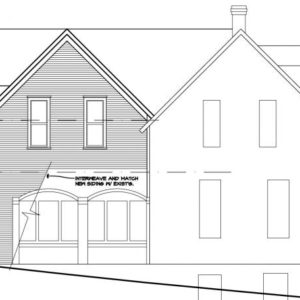
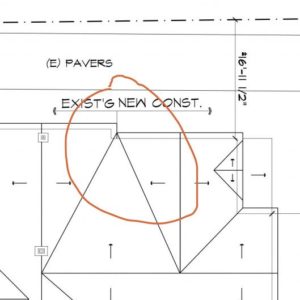
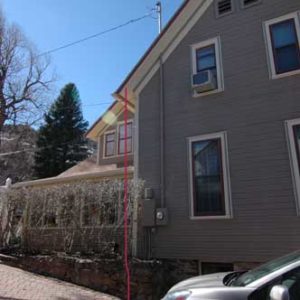
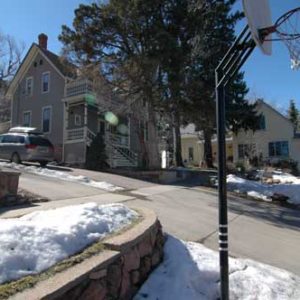
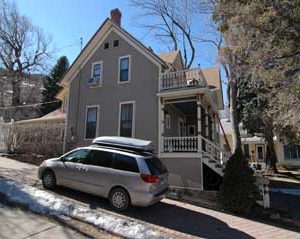


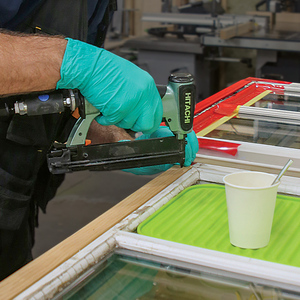
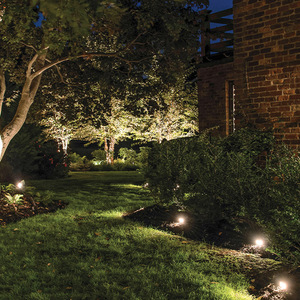















Replies
Here is the elevation/plan.
Thanks.
Seth
Edited 2/24/2007 3:24 pm ET by SethFrankel
The roof section that comes to a point at the bottom of the two valleys- take that section make the pitch slightly lessfrom the peak so the bottom is 12" wide instead of a zero point. Insulate well and prevent ice damns but use I&W liberally.then if you need to control water, have a good sheet metal man build a large decorative scupper to cath and lead the water, but do not damn it up more with a wall and small scupper. That would make the problem worse and look bad.East side there means morning sun good but drifted snow bad
Welcome to the Taunton University of Knowledge FHB Campus at Breaktime. where ... Excellence is its own reward!
What Piffen said, except make sure the leader box is low enough so that if it freezes, melt can't back up onto the roof, but drips off the front instead.http://logancustomcopper.com
http://grantlogan.net/
It's like the whole world's walking pretty and you can't find no room to move. - the Boss
I married my cousin in Arkansas - I married two more when I got to Utah. - the Gourds
Shoot the architect.
That was my first thought, but today it's my turn to be polite
Welcome to the Taunton University of Knowledge FHB Campus at Breaktime. where ... Excellence is its own reward!
Dont they make an electric element to warm the roof there to keep it from ice damming?And is it worth doing?
ANDYSZ2WHY DO I HAVE TO EXPLAIN TO FRIENDS AND FAMILY THAT BEING A SOLE PROPRIETOR IS A REAL JOB?
REMODELER/PUNCHOUT SPECIALIST
>>>>>Dont they make an electric element to warm the roof there to keep it from ice damming?And is it worth doing?That's basically the same thing as putting a tent over the house so the roof doesn't leak. Design and execution will solve the problem 99% of the time without having to resort to things like heat cables.http://logancustomcopper.com
http://grantlogan.net/
It's like the whole world's walking pretty and you can't find no room to move. - the Boss
I married my cousin in Arkansas - I married two more when I got to Utah. - the Gourds
Well, I'd rather not commit to a heat cable. While damming is a concern, I think that we can certainly design the insulation to prevent that. I'm really more concerned with such a large surface of roof and possible snow to melt and overwhelm the gutter/downspout. I do appreciate the idea of a flat spot, but guys, where's your sense of historic roof pitch! I'd say that the design is rather committed to this angle...the front portion of the house is driving the angle so the new back is just following suite.Maybe a separation of the two roofs with keeping the same pitch? I do have very severe limitations as to foot print in this project so pulling them apart will be really challenging.Thanks.
Seth
>>>>>>>where's your sense of historic roof pitch!It's right beside our sense of historic roof problems.http://logancustomcopper.com
http://grantlogan.net/
It's like the whole world's walking pretty and you can't find no room to move. - the Boss
I married my cousin in Arkansas - I married two more when I got to Utah. - the Gourds
Ouch.
Your drawing dioes not allow the same historic poitch as show now so why worry whether you are changeing from 12/12 to 7/12 or to 6/12?
Welcome to the Taunton University of Knowledge FHB Campus at Breaktime. where ... Excellence is its own reward!
Those are afterthoughts to cover for bad design and willhelp with the ice problem but not the bottle neck of excessive water flow
Welcome to the Taunton University of Knowledge FHB Campus at Breaktime. where ... Excellence is its own reward!
ROFLMAO!!
My thoughts exactly!
When you're this good, EVERYONE wants a crack at you!
http://www.petedraganic.com/
This design and your needs to accomodate the water flow and the protection from ice backup are at odds with one another.
It would be possible in a warmer climate to control the water flow thru a method like you suggest. When you have potential for backup issues then it would be more beneficial to not try and constrain the flow.
To capture the amount of fast flowing water in warm weather you would need a substantial barrier at the base of those valleys or the water will shoot right over your gutters. If you were to do that to control warm weather run off, it will impede the cold weather precipitation from being able to slide off or flow increasing the likelihood that you'll have backup- no matter what insulation and venting you undertake.
If your design is cast in stone and you must control the water flow- then be prepared to use metal in that area up both valleys for at least 8' including the center section- leading up to a large scupper and front wall.
This is not an easy solution to do all that you need in that climate.
Walter
Thanks, Walter.Reading the various suggestions, perhaps I should consider lowering the south peak (lefthand in the drawing). I can lower it probably a foot or so and thereby widen the area that joins the existing roof. I appreciate the conflict you point out about fast flowing water spilling over and cold water damming and freezing. It sound like we'll need to consider carefully the materials in that area, do as much metal as possible, and dramatically oversize the gutter/downspout configuration to deal with this.I appreciate the advise.Seth
Shoot ..... who??? ;o)
Jeff
Edited 2/25/2007 1:21 am ET by Jeff_Clarke
Good looking! Thanks for posting.Seth
That scupper head is the kind of collector I was referring to.If you cahnge roof pitch to have a 12" eave on that section, the collector can be shaped similar to the triable that is left at the vertex of the adjacent roofs so the pitch change never shows. all - could somebody reply to me? I have a hanging reply because I got one that was deleted and this thread will be popping up in my folder forever unless I can relink that cookie.
Welcome to the Taunton University of Knowledge FHB Campus at Breaktime. where ... Excellence is its own reward!
reply
Thanks!
Anybody ever tell you how fast you are?
Welcome to the Taunton University of Knowledge FHB Campus at Breaktime. where ... Excellence is its own reward!
Just returning the favor, you helped me yesterday with tiny text.
Seth,
The picture Jeff has posted is for a decorative item- conductor head.
The water from a gutter is conducted into this then the downspout is fastened at the bottom. This item isn't weant to act as a scupper at roof level, but secured under the soffits as a decorative feature.
You could have fabricated something more rugged which might be incorporated though.
Walter
Decorative ... but also very functional. Available in 20 oz copper - in my book that's pretty damn rugged (just bought one in 20 oz.). I see nothing wrong with a conductor head taking water from a valley as opposed to gutters - right? He could also have a 20 oz. copper collection box fabricated to pick up drainage at the roof level.
See attachment for one we just had made up - for a 90 degree intersection. Pardon the markups!
Jeff
Jeff,
Yes 20 oz. is fairly rugged- plenty strong if that were used under the soffits and possibly strong enough if used at roof level too.
I wasn't finding fault with it - just pointing out it was meant for another application.
Certainly Seth could have something fabricated for this specific location that could collect rainwater and discharge it. The problem arises when it's no longer liquid.
See attached pictures. I was shooting into the sun so they didn't come out great.
Walter
Seth,
I just posted some pictures of a roof with valleys meeting at a narrow point. Previous post to Jeff Clarke. This area faces North so it gets no sun all Winter.
Many Winters I've had to manually remove the huge ice and snow deposits from both sides of this large dormer. It can't free itself once ice starts forming.We haven't had huge storms this Winter so this area hasn't leaked yet. One more good snow storm and it well might.
In your case if it were to rain once you had socked in snow and ice it could be a big problem. There are a number of possible methods to adopt if the design must remain as is.
Walter
Walter,Goodness! That's a photo I'd rather not be able to take at this house!The good thing in Colorado is that it's rarely cold for more than a few days in a row and the sun is rather strong even in worst of winters. The issues here will be the fast snow and then a quick melt that would overwhelm. Ice damming can (and will) occur, but it's not as quite dramatic as I think you'll find in your neck of the woods.Thanks.Seth
Seth
There is one more radical thing that I've thought of in regards to ice forming then back up occuring. I'm going to take a picture later today of a situation similar to yours- except it faces North.
It may be in that small area at the bottom of those valleys which will lock in snow and ice even without an elevated scupper- you might consider a loop of radiant heat underneath the roofs sheathing just in that area. This would keep the accumulations able to flow out of this bottleneck and not able to form an ice dam.
They use radiant for sidewalk heating so why not in this somewhat unusual situation.
Picture will be posted later after I return from Bangor.
Walter
Walter,I'll look for the photo later. FYI, there will be radiant in-floor heat at that location on the second floor. Of course, I'd worry about freezing of the radiant tubing, if the whole system was not also injected with glycol.Thanks for taking the time to help problem solve.Seth
I do like those pavers, however!
Nice pattern. How's it do when plowing, shoveling, or blowing?
Thanks.The pavers are just fine in the winter. Sure, there's a little snow that's always between the tracks, but it's really not a big deal. I've used a snowblower just fine as well.In my situation, the trick is the water that dumps from the existing gutters and refreezes. I'm thinking about creating an open channel down the center with a metal grill and run all the water from this problem roof area down that channel into the street (i.e. skating pond in the road...).It's been in place for about six years, so there are definately tire tracks that are about 1/2" lower than the center/edges, but it doesn' effect the use. Of course, I'm expecting to need to take up the pavers and level the sand again after this construction project...Seth
Seth,
The scupper idea is about the only "normal" solution to this, however, it may look grossly out of place on the front of this home. IT would have to be large enough to capture the large amount of water being funneled to the point... and would have to drain fast enough, meaning a large-diameter drain pipe... then you have the dynamic of swirling causing a loss of efficiency in draining.
Not to mention the severe problem of ice damming for a considerable distance up the roof.
If you leave as is, you will DEFINITELY want to add a heater cable.... not to the roof but inside the scupper and drain pipe to keep it from damming.
Here is another idea.... don't know if it would conform to your situation but I would consider cutting a trough drain into the roof in that valley... like maybe 4' from the bottom... maybe even 6' up. this can be flashed and drained from below (inside the attic) and then exited elsewhere.
OR
you could build a built-in gutter at the same height, on the surface of the roof and drain that along the exterior. I'm talking about the type they used to be an integral part of the roof. I don't recall the name at the moment. This would divert the water before it came to the point of concentration where it becomes problematic.
When you're this good, EVERYONE wants a crack at you!
http://www.petedraganic.com/
Edited 2/25/2007 11:28 am ET by PeteDraganic
Thanks, Pete. Both interesting ideas and worth toying around with. I think this might be a situation to implement a few of these ideas rather than hoping a single solution will work.Seth
See attached.
Ice dams are caused by heat escaping through the roof. Heating with cables ABOVE the roof is a totally different concept - and much new construction in Colorado does it - it's not a design flaw there to need it.
http://www.chromalox.com/products/prodinfo/en/srfrg.html
Jeff
Edited 2/25/2007 10:01 pm ET by Jeff_Clarke
Jeff,You rock.Thanks for taking the time to provide such detail.Seth
My pleasure!
Jeff
That's what I was suggesting with an electric heating element he could still put on the scupper and run heat in the scupper and under the roof to keep the icedam from forming at the bottle neck but others thought that too gimicky.
ANDYSZ2WHY DO I HAVE TO EXPLAIN TO FRIENDS AND FAMILY THAT BEING A SOLE PROPRIETOR IS A REAL JOB?
REMODELER/PUNCHOUT SPECIALIST
Andy,
I think people thought you were suggesting a heat cable externally- I'm thinking that a loop inside the structure might have merit.
Walter